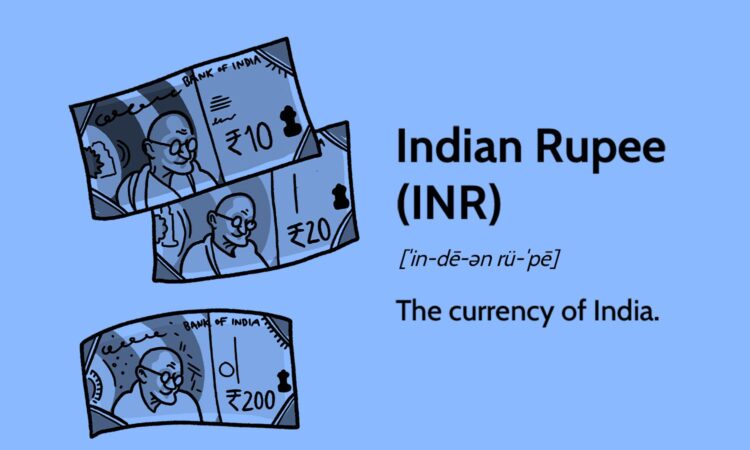
The primary medium of exchange in India is the rupee (INR). It was introduced as a silver coin by Sher Shah Suri in the 16th century. The rupee then became a fiat currency under British colonial rule. Now it’s another currency within the modern monetary system and is managed by the Reserve Bank of India (RBI).
The currency exists in various denominations and incorporates security features to prevent counterfeiting. While the rupee is not a significant reserve currency elsewhere, neighboring nations like Nepal and Bhutan peg their currencies to it, highlighting its regional importance.
Key Takeaways
- INR operates under a managed floating exchange rate system, where its value is determined by market forces but regulated by the Reserve Bank of India (RBI) to prevent excess volatility.
- Inflation, domestic and foreign interest rates, foreign exchange reserves, trade balance, and global oil prices influence the rupee’s value and purchasing power.
- The rupee has historically faced long-term depreciation because of structural economic factors, but RBI intervention and increasing forex reserves help stabilize short-term fluctuations.
- India has promoted rupee-based trade settlements with key partners
- The RBI is developing a central bank digital currency (CBDC), part of a process that has seen the country depend less on physical currency and more on digital alternatives.
What Is the Indian Rupee?
India’s currency is managed within the world currency market’s floating exchange rate system. Thus, the value of the rupee changes based on economic and financial market factors. While the rupee is freely convertible for trade and remittances, capital account transactions are restricted to manage economic stability, and the RBI intervenes from time to time to curb too much volatility.
India’s financial landscape has evolved with the rapid shift to digital payments through platforms and mobile wallets. This reduces the reliance on cash and improves financial transparency. Although the rupee faces challenges like depreciation risks, inflationary pressures, and external debt exposure, growing foreign exchange reserves and increasing foreign direct investment (FDI) provide stability.
Efforts to internationalize the rupee, including promoting rupee-based trade and developing a central bank digital currency (CBDC), indicate India’s commitment to strengthening its financial system.
Tip
A CBDC is a digital form of a country’s fiat currency that is issued and regulated by the nation’s central bank.
The Rupee’s Value
Historically, the rupee has depreciated because of higher inflation, trade deficits, and structural economic challenges. This is despite structural reforms such as increasing manufacturing, exports, and foreign investment that have worked to strengthen the rupee.
Multiple economic, financial, and geopolitical factors affect the rupee’s value. Nonetheless, because of its managed floating rate system, the RBI can enter the market to prevent extreme volatility. Some of the factors include the following:
- Inflation: Higher inflation in India relative to its trading partners reduces the purchasing power of the rupee, making it weaker. A stable and controlled inflation rate helps maintain stability.
- Interest rate differentials: The difference between India’s interest rates and those of other countries affects capital flows. Higher RBI rates attract foreign investment, strengthening the rupee. Inversely, lower rates encourage capital outflows, weakening the rupee.
- Foreign exchange reserves: India’s forex and gold reserves act as a buffer against rupee depreciation. Higher reserves provide confidence in the rupee, reducing speculative pressure.
- Trade balance: A trade deficit puts downward pressure on the rupee because of increased demand for foreign currencies. Meanwhile, a trade surplus strengthens the rupee by increasing foreign exchange inflows.
- Geopolitical and global market trends: Global events like U.S. Federal Reserve policies, geopolitical tensions, and investor risk appetite influence rupee movements.
- FDI and foreign portfolio investment (FPI): FDI strengthens the rupee by increasing demand for INR. It should be noted that FPI is more volatile than FDI, with outflows weakening the rupee while inflows strengthen it.
- Oil Prices: India imports over 80% of its crude oil, making the rupee highly sensitive to oil prices because higher oil prices increase India’s import bill, increasing demand for U.S. dollars and weakening the rupee.
Examples of the Indian Rupee
The rupee comes in various forms including coins and banknotes, all of which are legal tender across India. The banknotes display Mahatma Gandhi and have sophisticated security features like watermarks and color-shifting ink to prevent counterfeiting. Each note has a distinct color and design, making it easily recognizable.
Investopedia
The Bottom Line
The rupee is a key part of India’s economy, evolving alongside the nation’s rapid growth and modernization. As a currency governed by a managed floating exchange rate, its value is shaped by a mix of domestic and global economic forces, from inflation and interest rates to trade balances and foreign investments.
While the rupee has experienced long-term depreciation, strong foreign exchange reserves and strategic RBI interventions have helped stabilize its short-term fluctuations. With India’s push toward digitalization, financial inclusion, and internationalization efforts, the currency is gradually adapting to a dynamic global financial system.



